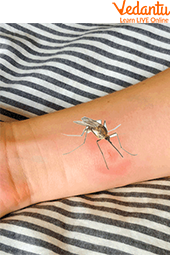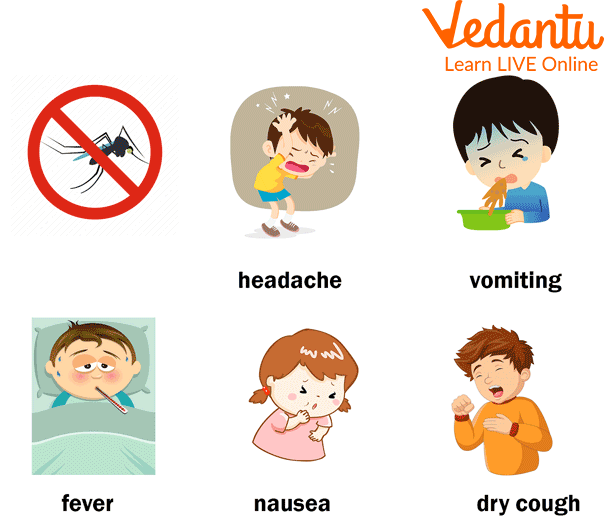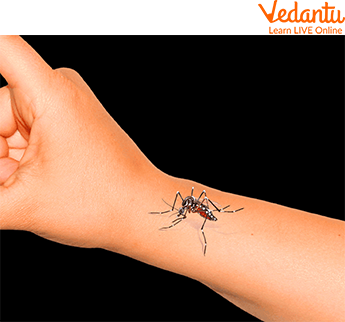




An Overview of Malaria
During the monsoon seasons, if there is one prevalent and widespread disease that infects a lot of people, it has got to be Malaria. Malaria is a severe and dangerous mosquito-borne disease that is mostly seen in tropical areas. In this article, we will learn a lot about this illness. From its causes to its symptoms and diagnosis, we will cover everything that a layman needs to know about this fatal disease. We will also have a look at symptoms, diagnosis, treatment and prevention in this article. Let’s go ahead and know some of the malaria symptoms in kids and adults as well.
Malaria and Its Origin
In hot and tropical areas such as the Asian and African continent, Malaria is a common infection. The term malaria comes from the Italian terms mala and ria which mean bad air. The earlier theories said that this illness was caused by bad air from marshlands. Hence, the term malaria originated.

Mosquito Bite
Causes of Malaria
Malaria is a disease that is caused by a mosquito bite. A female Anopheles mosquito is infected by the parasite called the Plasmodium parasite, if bites a human, it results in malaria. It is said that these malaria parasites evolved in the tropical parts of Africa, more than 2.5 million years ago. When a human gets bitten by these parasite-infected mosquitoes, the person begins to show the symptoms of malaria.
Signs and Symptoms of Malaria
The symptoms of this mosquito-borne disease are dangerous and have a lot of adverse effects on the human body. Following are some of the most common symptoms that occur among patients having malaria.
Fever
Nausea
Coughing
Vomiting
Diarrhoea
Weakness
Headache
Muscle pain
Remember that malaria is a fatal disease. If a person shows several signs among these, he/she must be taken to the doctor immediately without wasting time. Once the treatment is obtained properly, the symptoms begin to go away within a few days.
If not treated in time, the illness gets worse rapidly and can cause severe symptoms that might lead to loss of life as well. This is why one must make sure to get diagnosed by a qualified doctor right in time. The sooner one gets diagnosed, the faster the treatment. Let us know a little more about how malaria is diagnosed, treated and prevented.

Signs and Symptoms of Malaria
Diagnosis of Malaria
Based on the patient’s symptoms, a doctor can suspect and diagnose malaria. With the help of a blood sample, malaria-infected red blood cells are observed to confirm the disease. Even the type of parasite that has caused infection can be diagnosed with the blood samples.
Your doctor will most likely evaluate your medical history, and recent travels, perform a physical exam, and order blood tests to identify malaria. Blood testing may reveal:
To determine if you have malaria, the blood must have the parasite present.
Your symptoms are being caused by what kind of malaria parasite?
If a parasite that is causing your infection is resistant to some medications
Whether the illness is resulting in any severe side effects

An Infected Female Anopheles Mosquito
Treatment and Prevention
Just like other diseases, malaria can be treated with specific types of medicines. Though there are some other factors as well that decide the duration of the treatment. Factors such as the age of the infected person, the severity of the illness, type of parasite, etc.
With the advancement in modern pharmaceutical drugs and treatment methods, the treatment has become safe and secure if diagnosed at the right time. But we must also make sure that we avoid getting infected with the illness in the first place. As the old saying goes, “Prevention is better than cure”.
For the prevention of malaria, make sure you don’t get bit by mosquitoes. Use a mosquito net while sleeping and usage of insect repellent while going out will also help. Putting screens on windows will also be a good way to prevent malaria. Keep your surroundings clean and treat the things you use with insects repellent.
Summary
Malaria is as scary as it sounds. It is an illness that is caused by a parasite called the Plasmodium parasite. If a female Anopheles mosquito, infected with this parasite, bites someone, the person might start to show severe symptoms of malaria within a week. In this article, we learned the malaria symptoms that occur in adults as well as kids. We also looked upon the diagnosis of this illness and its treatment. Malaria is a fatal disease, which is why one must take care of proper treatment to avoid severe complications. Do not ignore any symptoms of malaria, see a doctor if you feel you have malaria. I hope this article will be beneficial for you. Feel free to ask any doubts in the comments.
FAQs on Malaria Symptoms in Kids
1. Can malaria exist without fever?
Yes, it is possible. A person without fever or even mild fever can be malaria positive. Only a blood test will determine if you have malaria or not. If you’re feeling any symptoms, then just go for a blood test.
2. How long does it take to know if one has malaria?
Usually, malaria symptoms are noticed in the person 10 days to one month after he/she was affected. Malaria is not a contagious disease i.e. it does not spread like cold and flu from human to human. Usually, chills and shivering are the first signs of malaria.
3. What types of food should one not eat in malaria?
If one has malaria, the person needs to avoid fried foods, refined foods like bread, pizza, and burgers, and sweets like cakes, cookies, and desserts. High fibre foods should also be avoided like green leafy vegetables, whole grain cereals etc. One should consume fructose-containing foods while suffering from malaria, milk is also a good substitute.









